| Jun-27-03 | | akiba82: Mason uses psychological warfare against Janowski. He delays castling while beginning aggressive action on the kingside by pushing his g pawn. He later castles queenside and opens the h file with a winning attack. Janowski could have defeated this strategy with 24... Bd4 25 cd4 (not Qd4 Qb2) Rac8 and White's king is stuck in the center. But Mason knew that Janowski, a great devotee of the two bishops, ( " the two Jans" ), would not make this move! After 39 Qh4 Black is in hot water. White's knight is far superior to Black's bishop and he threatens Qh8 and Rh7 winning. Accordingly comes 39... Qe5 covering h8. After 40 Nf3 Black cant defend against the double threat of either Qh8-f6+ with Rh8# or Qc4+ picking up the bishop. A good example of " the slowly developing attack " with less material of which Mason was a pioneer. |
|
| Jun-28-03 | | euripides: Akiba82 - a very interesting game. The early advance of the g pawn has a strikingly modern feel, with the option of long-run space games on the kingside or a fierce Kingside attack- it reminds me of some of Fischer's games on the white side of the Sicilian. Lasker pioneered the advances of the g pawn against the Sicilian at about the same time (e.g.Lasker-Napier). |
|
| Jun-29-03 | | akiba82: Euripides- there is some similarity between the game and Lasker-Napier, although I never noticed it until you pointed it out. I do know Lasker had great respect for Mason and felt he could have been world champion had he been more disciplined in his personal life. |
|
Aug-25-19
 | | KEG: Janowski's result against Mason were a curiosity. He defeated Mason in their first encounter (Leipzig 1894) and drew their next game (at Hastings 1895). But during his final seven games against Mason during the period 1899 to 1902--during which time Janowski achieved some spectacular results while Mason generally languished towards the bottom of the draw, Mason's record against Janowski was an incredible 5 wins against one loss and one (replayed) draw. At the gigantic double round-robin tournament at London 1899, Janowski finished tied for 2nd-4th with Pillsbury and Maroczy behind only the mighty Lasker. Janowski would have finished in undisputed second place had he not lost both his games to Mason. At Monte Carlo 1901, Janowski finished first. He lost only two games in registering this triumph. One was to Alapon. The other was to Mason. At Monte Carlo 1902, Janowski took third, 0.75 point behind the tourney winner Maroczy and a half-point behind Pillsbury. Janowski would perhaps have won the tournament had he not lost his game to Mason (who finished 13th). At Hanover 1902, Janowski finished first ahead of Pillsbury, Tchigotin, and Marshall. Janowski lost only one game at Hanover 1902--which was to (your guessed it!) Mason (who finished in next-to last place). How can this be explained? The present game perhaps provides some answers. Mason's play here exploited all that was worst in Janoswki's repertoire. This was a double-edged game in which Mason staked all on an almost certainly flawed King-side attack. Janowski was an attacking genius, but he lacked the patience to play tight defense. So here, Mason's coffee-house attack went unpunished. Janowski let Mason off the hook, and when Janowski found his edge evaporating, he lacked the calm to obtain the draw that was probably his for the asking and got wiped out when he underestimated Mason's remaining King-side attacking chances. This was a game Janowski didn't have to lose. He Janowski not later managed to defeat Schlechter, it would have been the latter, and not Janowski, who would have been the victor at Monte Carlo 1901. 1. e4 e5
2. Nf3 Nc6
3. Bc4 Bc5
4. Nc3 Nf6
5. d3 d6
6. Be3
6. Na4 or 6. Bg5 were better on paper, but Mason knew that Janowski--who loved his two Bishops--would decline to exchange. 6... Bb6
As Mason may have anticipated, Janowski declined to play the stronger 6...BxB. 7. Qe2
7. BxB would have been better on paper, but Mason may have decided to see what further dividends he could obtain by Janowski's reluctance to swap Bishops. 7... 0-0
8. h3
8. 0-0 or 8. Bg5 were better. But Mason decided to restrict Janowski's White-square Bishop. 8... Nd4!

click for larger viewJanowski has already assumed the initiative (as Black) and had obtained the better game by move eight. 9. Qd2
The Tournament Book correctly notes that Black would be better after 9. BxN exB 10. Nb1 (10. Nd5 seems better) d5, but White would be only slightly worse had he played 10. Nd5 in this line, and Black is also for choice after the text, which accomplished little. 9... Ne6
9...Be6 and 9...Nxf3+ were better, as was 9...Re8 10. Bb3
"Intending Ne2." (Tournament Book).
I prefer 10. 0-0 or 10.BxB or perhaps even 10. BxN. 10... c6
10...BxB (an unlikely choice from Janowski!) or 10...Ba5 seem better. 11. Ne2
The beginning of a bad plan. The simple 11. 0-0 or 11. BxB were better. 11... Qc7
12. g4?!
"?"--(Tournament Book)
"Creating a hole at f4." (Tournament Book)
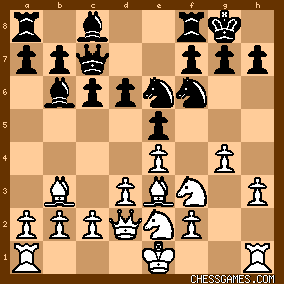
click for larger view12. 0-0 or 12. Ng3 or even 12. c3 were better. But Mason had decided to play offense against Janowski, and--as the sequel was to prove--this sort of wild attacking play was a good psychological ploy against the offensive minded Janowski. |
|
Aug-25-19
 | | KEG: Post II
12... a5
Commencing play on the Queen's side and forcing White to decide how to take care of his b3 Bishop. That being said, 12...d5 and 12...Nc5 were good alternatives. 13. a4
13. c3, 13. BxB, and perhaps 13. 0-0-0?! were Mason's main alternatives. Each of these moves has its points--and demerits. 13... Nc5
Well-played. Janowski will now get his most cherished advantages: the two Bishops! 14. BxN BxB
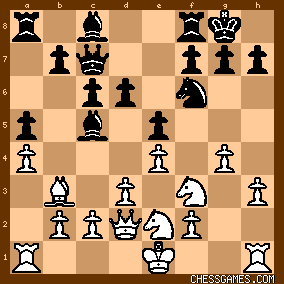
click for larger viewJanowski now had his cherished two Bishops, and Mason might have done best to castle King-side. But Mason's plan was to play for open lines and an attack on the King-side at all costs, and 15. 0-0 hardly fit that mold. 15. Ng3
Consistent--even if not best.
15... Be6!
At the possible cost of keeping the advantage of the two Bishops, Janowski decided to address any threats on the a2...f7 diagonal. 16. Ba2
Once again, Mason should probably have castled--if not on the King's side then on the Queen's side. 16... d5!
"Sooner or later, he will be compelled to [play] g6 because of Nf5; consequently, it would be better to take the Bishop thus preventing White from castling Queen-side and bringing the Rook into a bad [for Black] position." (Tournament Book) I completely disagree. Janowski had the edge at this point, and there was no reason for him to initiate trades that would only ease Mason's defense. 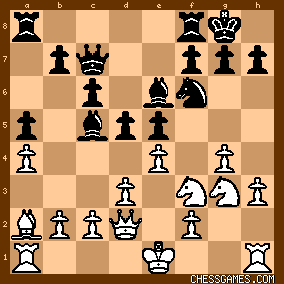
click for larger view17. g5?!
Over the top, no doubt, and something like 17. Qe2 or 17. 0-0 or 17. c3 was no doubt theoretically best. But Mason knew Janowski, and had decided to force him to have to play the kind of patient defense for which Janowski was so unsuited. 17... Nd7
18. Nh4?!
18. 0-0 was probably the theoretically best move. But 18. h4 looks like the best way to follow-up the wild 17. g5?! 18... Qb6
18...Rad8 was no doubt the best way to attempt to punish Mason for his over-reaching. But with Janowski at the helm, the text was probably predictable (and not all that bad). 19. c3 g6
19...d4 would have been very strong here. 19...Rad8, 19...Rfd8, or 19...dxe4 were all also likely better than the text. 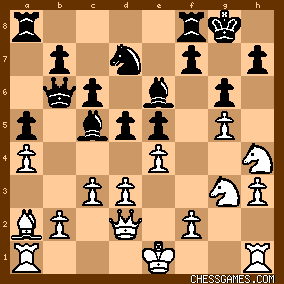
click for larger view20. Rh2?!
Staking all on his plan to double Rooks on the h-file and storm the Black King-side fortress. But the plan by this point was mis-guided (except perhaps against a sometimes one-dimensional player like Janowski. At least on the face of the position, 20. 0-0 or 20. Nf3 were better. 20... f6
The Tournament Book correctly noted that Black would forfeit all of this advantage on 20...f5 21. exf5 Bxf5 (this gives White good play, 21...gxf5 would be better). 22. NgxB gxN. But 20...d4 20...Bd6 or even 20...dxe4 were better ways for Janowski to seek to punish Mason for his temerity. 21. Nf3 f5
21...Rae8 was the main alternative.
After 21...f5, battle lines were drawn:

click for larger view |
|
Aug-25-19
 | | KEG: Post III
22. exd5
Mason could equally well have played 22. d4.
22... cxd5
22...Bxd5 looks sounder and better, but Janowski seemingly preferred the scary-looking pawn phalanx that results from the text. But Mason immediately put an end to that idea. 23. d4!
This took some of the sting out of Janowski's formidable center advance. But Janowski probably still had a strategically won game. 23... exd4
24. Nxd4
Stockfish here, deeming White to be in big trouble, recommends a heroic pawn sacrifice with 24. Ne2. That is a bit rich for my blood. Fritz, which also thinks White is in major trouble here, nonetheless sticks with the more prosaic test. After 24. Nxd4, one of the critical positions in this game was reached: 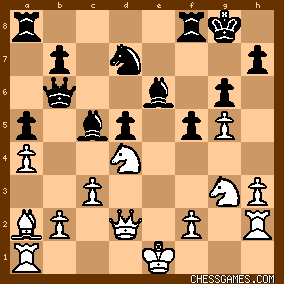
click for larger view24... Ne5?
Both the Tournament Book and akiba82 on this site (back in 2003) rightly prefer 24...BxN. 'This move [i.e., 24...Ne5] looks more threatening than it really is. The simple plan is 24...BxN." (Tournament Book) "Janowski could have defeated [Mason's] strategy with 24...BxN." (akiba82). The Tournament Book and akiba82 both give the following line: 24...BxN 25. cxB [Not 25. QxB? Qxb2] Rac8. "...preventing the escape of the king by castling with the better game" (Tournament Book) "...and White's King is stuck in the center" (akiba82) I am completely with the Tournament Book and akiba 82 through 25. cxB. But after the suggested 25...Rac8, White seems to be passed the worst after 26. Ne2 or 26. f4. Better by far is 25...f4 (26. Ne2 f3!) leaving White hanging on by his fingernails. After Janowski's 24...Ne5, the position was:
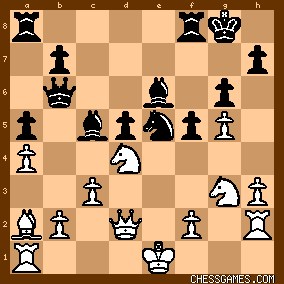
click for larger view25. Nge2
"!"
"The only move." (Tournament Book)
The text does appear forced, but it is effective and seems to have left Mason with a defensible position. 25... Nc4
"Of course, Janowski could have equalized the game easily here with 25...BxN 26. NxB QxN (simpler if Black is seeking only equality is 26...0-0) 27. cxQ Nf3+ 28. Ke2 NxQ 29. KxQ but he did not care to dissolve the position to its utmost simplicity." (Tournament Book) While the above line is cute, why would Janowski want to trade down to an even endgame when he still had much the better game (not to mention his beloved two Bishop)? The text was clearly best, and the idea underlying 25...BxN is ridiculous absent severe time-pressure (of which there is no record) or fear that one is playing a far superior opponent (hardly the case with Janowski). 26. BxN dxB

click for larger viewSome of the steam may have been lost from Janowski's previously powerful position, but he still had much the better chances. Not much seemed left of Mason's attempted King-side attack. But--as will be seen--Mason thought otherwise, and the game from here became very exciting. |
|
Aug-25-19
 | | KEG: Post IV
27. 0-0-0 ?!
"White is now in safety, and may assume the counter-attack." (Tournament Book) This is nonsense. The position is double-edged, and Janowski's pressure on the Queen-side was dangerous. 27. h4 was most prudent. But Mason was staking all on his King-side attack, and he wanted to bring both Rooks into play and brave whatever would befall his King. 27... Bd7!
Eliminating the chance that Mason would trade Knight for Bishop and preparing his light-square Bishop for action on the Queen-side: 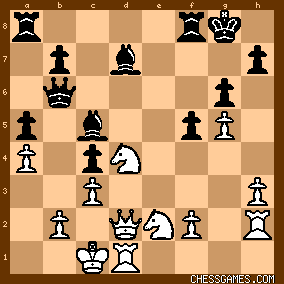
click for larger viewWith 27...Bd7, a new theme came into play---when and if Janowski could play Bxa4. As will be seen, it was the timing of this capture that was to decide the game. 28. Qc2 Rae8
This looks strong for Janowski. 28...f4 was another interesting idea. 29. h4 Bd6
Better was 29...Qd8 or 29...Qc7. The text, however, managed to distract Mason and slow down whatever King-side attack he was hatching. 30. Rhh1?
This can't be right. Among other things, it gives up on the idea of doubling Rooks on the h-file. Much better was 30. f4 or maybe 30. Ng3. After 30. Rhh1, the position was:
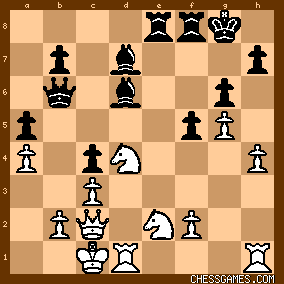
click for larger view30... Re4?
Much too slow, and surprising coming from Janowski. 30...f4! was the way to force play. 31. h5!
For Mason's attacking scheme to have any chance, he had to open the h-file. 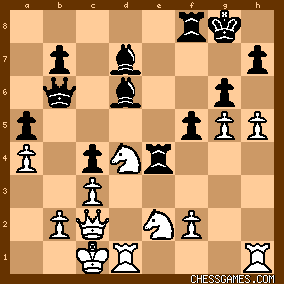
click for larger view31... Qd8
Janowski was apparently nervous about Mason's aggressive plan. 31...Be8 or 31...Rf7 were his only chances to maintain some semblance of his prior advantage. 32. Rdg1
Hardly best. 32. hxg3 was indicated. Other reasonable choices for White were 32. Qd2 (sacrificing the a4 pawn and staking all on his King-side attack) or 32. f3. 32... Rg4
"?"--(Tournament Book)
"32...Qe8 was a very strong, possibly winning continuation." (Tournament Book) While 32...Rg4 was far from best, and while 32...Qe8 was indeed an improvement, it hardly led to a "winning continuation," e.g. 33. hxg6 hxg6 34. Qd2 f4 with about equal chances (and not 34...Bxa4? 35. Rh6 with a likely winning attack. The best choice here, and the only move to allow Janowski to obtain any advantage, was 32...Be8. But this would involve the kind of tight defense that would suit someone like Karpov beautifully but was not part of Janowski's mindset. The text (32...Rg4) led to double-edged play; a course far more suited to Janowski's style even if not theoretically "best." After 32...Rg4, the position was:

click for larger view |
|
Aug-25-19
 | | KEG: Post V
33. Qd2
Abandoning the a4 pawn (which Janowski could obviously not capture at this point because of 33...Bxa4 34. RxR fxR 35. Ne6). 33... RxR+
33...gxR may be slightly better.
34. RxR
Mason could also have played 34. NxR
After 34. RxR, the position was:

click for larger view34... Qe7
Janowski was beginning to lose the thread of the game. 34...Bh2 or 34...Ee8 were better. Janowski could still not afford to snatch the a4 pawn because 34...Bxa4 would still lose to 35. Ne6. 35. hxg6 hxg6
36. Nf4 BxN
Janowski must have been chagrined to have to part with one of his two Bishops, but he had no choice at this point. 37. QxB
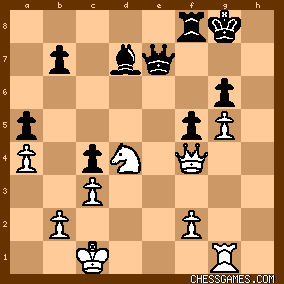
click for larger viewJanowski here should have taken the a4 pawn. This would have led to thrilling play, but Janowski could likely have survived: 37...Bxa4 38. Rh1 (or 38. Nxf5 immediately) Rf7 39. Nxf5! RxN 40. Qxc4+ Rf7 41. QxB Qxg5+ 42. Kb1 Rxf2 43. Qc4+ Kg7 44. Qc7+ Rf7 45. Qb8 Qf5+ 46. Ka1 Re7 46. Qa8+ Kf7 47. Rh7+ Ke6 48. Qe6+ Kd6 49. Qd8+ Rd7 50. Qb6+ Ke5 51. Qxa5+ with a likely draw. But here, Janowski erred with:
37... Re8?
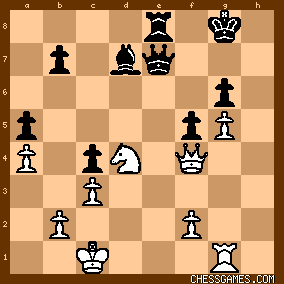
click for larger view38. Rh1
This may be sufficient to win, and was in accordance with Mason's plan. But even stronger was 38. Qc7! After 38. Rh1 the critical position was reached: 
click for larger view38... Bxa4?
"?"--(Tournament Book)
"Black has no time for this recapture. 38...Qg7 is compulsory." (Tournament Book) 38...Bxa4? was indeed a fatal blunder (Janowski must have overlooked Mason's 40th move, as the Tournament Book opines), but the Tournament Book's suggested 38...Qg7 was not much better: 39. Qd6! Re7 40. Rh6 (40 f4 is also very strong here) Qe5 41. Rxg6+ Kh8 42. Qf6+ QxQ 43. RxQ Bxa4 (or 43...Re1+ 44. Kd2 Rb1 45. Rf7 Bxa4 46. Rxb7) 44. Rxf5 Janowski's only chance lay in 38...Qe5, although he would still face an uphill struggle after 39. Qh4. After 38...Bxa4?, the position was:

click for larger view39. Qh4!
"After 39. Qh4, Black is in hot water. White's Knight is far superior to Black's Bishop, and he threatens Qh8 and Rh7 winning." (akiba82). 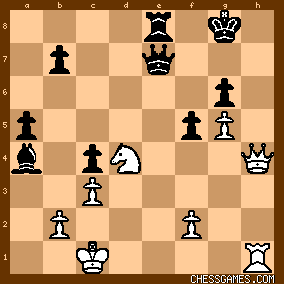
click for larger viewAs akiba82 and the Tournament Book correctly note, Janowski now had no way to handle all of Mason's threat. In practice, and as will be seen in my next post on this game, Janowski's resistance crumbled here, and Mason finished off the game quickly. |
|
Aug-25-19
 | | KEG: Post VI
39... Qe5?
"?"--(Tournament Book)
"Covering h8." (akiba82)
The text does guard against Mason's threatened mate (he had threatened 40. Qh8+ Kf7 41. Qf6+ Kg8 42. Rh8 mate), but falls into a fork that costs him his Bishop. Relatively best was 39...Qg7. This would not likely have saved the game for Janowski (e.g., 40. Nxf5! gxN 41. Qxc4+ Kf8 42. QxB Qxg5+ 43. f4 Qg6 44. Qd7), but it was certainly better than the text, which leaves him down a piece and in a hopeless position: 40. Nf3!
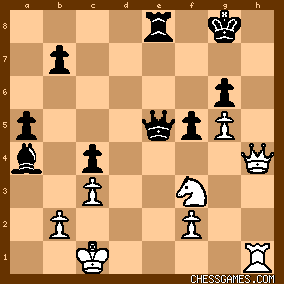
click for larger view"!"--(Tournament Book)
"This pretty move Black overlooked, and he must lose a piece, as he cannot defend both the mate and the c-pawn. The rest is plain sailing." (Tournament Book) "After 40. Nf3 Black cannot defend against the double threat of either Qh8+-Qf6+ Rh8 mate or Qc4+ picking up the Bishop." (akiba82). 40... Qd6
Janowski chose not to get mated, and instead gave up his Bishop. 41. Qxc4+ Kg7
42. QxB
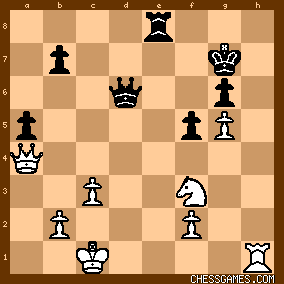
click for larger viewGame over? Not with Janowski, who tried desperately to alter fate. 42... Re4
43. Qd1
This didn't ruin anything, but the obvious 43. Qxa4 was simpler and faster. 43... Qc7
Trading Queens with 43...QxQ+ might have allowed Janowski to survive a bit longer, but was hopeless. Janowski decided to keep Queens on the board (White's mating threats notwithstanding) in the vain hope of finding some tactical trick to save himself. 44. Nd4
44. Rh6 or 44. Rh3 would be immediately crushing, but--once again--Mason's move didn't spoil his winning chances. 44... a4?!
Desperation. 44...Qf4+ would be the best way to prolong the game, but Janowski was playing for miracles at this point. 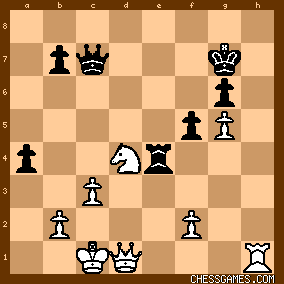
click for larger view45. f3
If Mason had recourse to a computer, he could have played the spectacular 45. Nf5+ which is completely crushing even though it sacs a piece (45...gxN 46. Qh5), but the text was absolutely best for human play over the board. 45... Re7
45...Re8 was the only way for Janowski to hold on for even a little while. 46. Qxa4
Again "missing" the spectacular computer line beginning with 46. Nxf5+, but making sure of the win. 46... Qf4+
Not the way to defend his King, but as mentioned above Janowski was now playing for miracles. 47. Kb1 Qxg5
47...Qd2 would have prolonged the game a few moves perhaps but would not have changed the outcome. 48. Qa8!
Even a mere human can now see that the game is over. 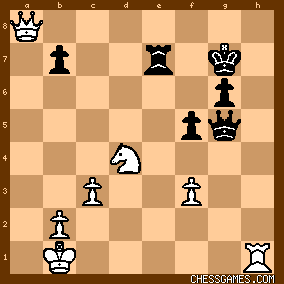
click for larger view1-0
Even Janowski did not care to play on any longer from here. |
|
|
|
|





































